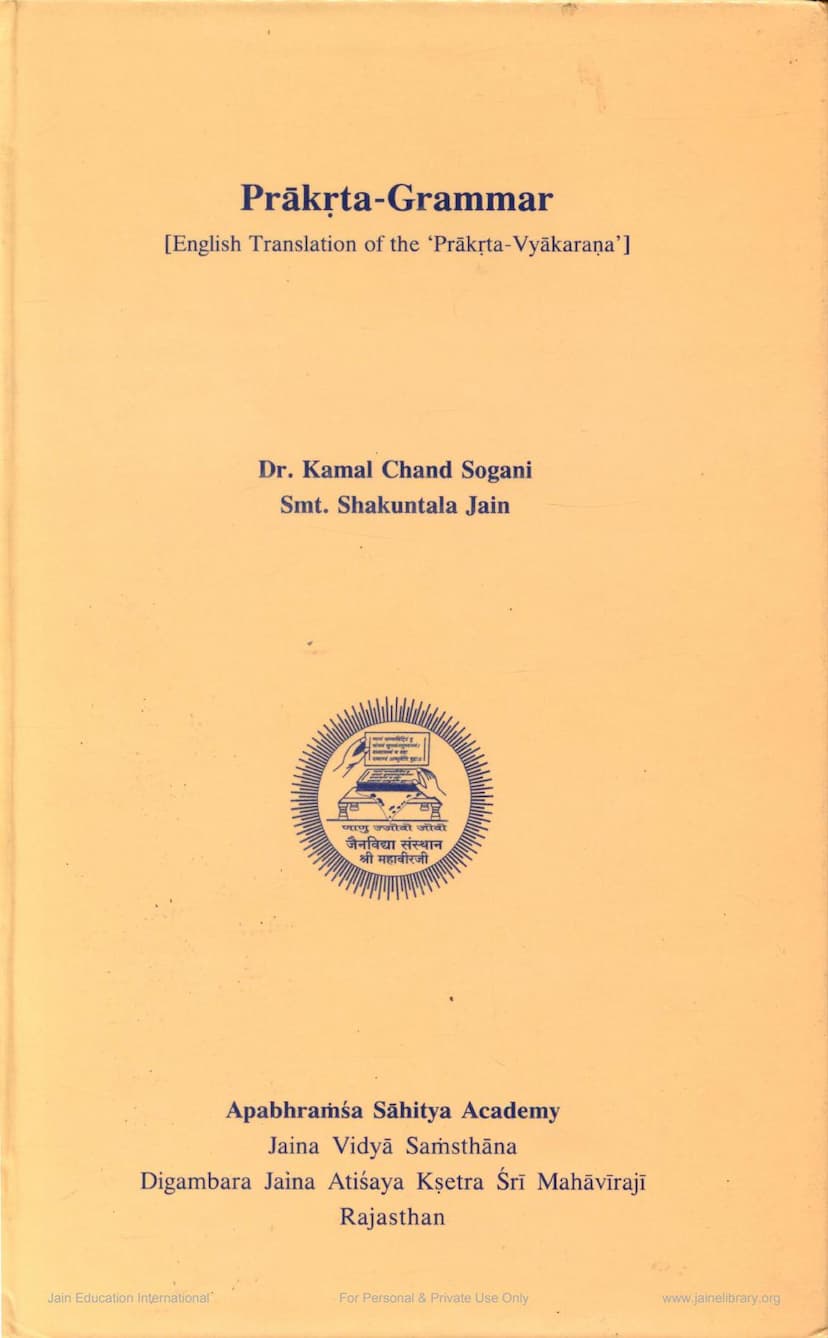Prakrta Grammar
Added to library: September 2, 2025

Summary
This document is an English translation of "Prākṛta-Vyākaraṇa" (Prākṛta Grammar) by Dr. Kamal Chand Sogani and Smt. Shakuntala Jain, published by Apabhramsa Sahitya Academy. The book aims to provide a comprehensive guide to the grammar of the Prākṛta language, which is described as an ancient and sacred Indo-Aryan language of India, essential for understanding the development of Indian literature and cultural heritage.
The book is structured into several chapters, covering various aspects of Prākṛta grammar:
-
Chapter 1: Combinations (Sandhi): This chapter deals with the rules of how sounds and letters combine in Prākṛta, including similar and dissimilar vowel combinations, the negation of vowel combinations, rules for disappearance of sounds, combinations in repeated words, and rules related to the anusvāra (nasalization). It also includes exercises for practice.
-
Chapter 2: Compounds (Samāsa): This section details the six types of compounds in Prākṛta: Danda Samāsa (Copulative), Tappurisa Samāsa (Determinative), Kammadhāraya Samāsa (Adjectival), Digu Samāsa (Numeral Adjectival), Bahuvvīhi Samāsa (Indirect Adjectival), and Avvaībhāva Samāsa (Indeclinable). Each type is explained with examples, and exercises are provided to identify and form compounds.
-
Chapter 3: Cases: This chapter elaborates on the eight cases in Prākṛta: Nominative, Accusative, Instrumental, Dative, Ablative, Genitive, Locative, and Vocative. It explains the usage of each case with numerous examples and includes translation exercises from English to Prākṛta. The agreement of verbs with subjects, and the nuances of object usage in transitive and intransitive verbs, are also discussed.
-
Chapter 4: Taddhita (Word-formation): This chapter focuses on suffixes used to form new words from nouns, pronouns, and adjectives. It details various suffixes like 'kera', 'kka', 'ikka', 'eccaya', 'vva', 'illa', 'ulla', 'huttam', 'imā', 'ttaņa', 'tta', 'tā', 'ittia', 'ālu', 'vanta', 'manta', 'itta', 'ira', 'mana', 'tto', 'do', 'o', 'hi', 'ha', 'ttha', 'si', 'siam', 'iyā', 'tara', 'tama', and 'manta', explaining their function in creating new words with specific meanings or grammatical functions.
-
Chapter 5: Feminine Suffixes: This chapter discusses how feminine gender is formed in Prākṛta, distinguishing between original feminine words and those formed with suffixes. It explains the common feminine suffixes like 'a' and 'i', and others like 'ana', as well as instances where suffixes are added or modified.
-
Chapter 6: Indeclinables: This chapter defines and categorizes indeclinable words, which do not change their form regardless of case, number, or gender. It covers five types: Prefixes, Adverbs (of place, time, and manner), Conjunctions, Interjections, and other Indeclinables. Numerous examples illustrate their usage.
The book also includes:
- Diacritical Marks: A guide to the diacritical marks used for vowels and consonants in Prākṛta.
- Appendices:
- Appendix 1: A glossary providing English to Prākṛta word index for nouns, adjectives, indeclinables, and verbs.
- Appendix 2, 3, 4, 5: Solutions to the exercises provided in Chapters 1, 2, 3, and 6 respectively.
- Reference Books: A list of books consulted for the preparation of this grammar.
The overall aim of the book is to equip students with the ability to compose sentences from English to Prākṛta and to understand Prākṛta grammar effectively, even without direct supervision. The translation follows the capitalization pattern of Wren & Martin's grammar book.